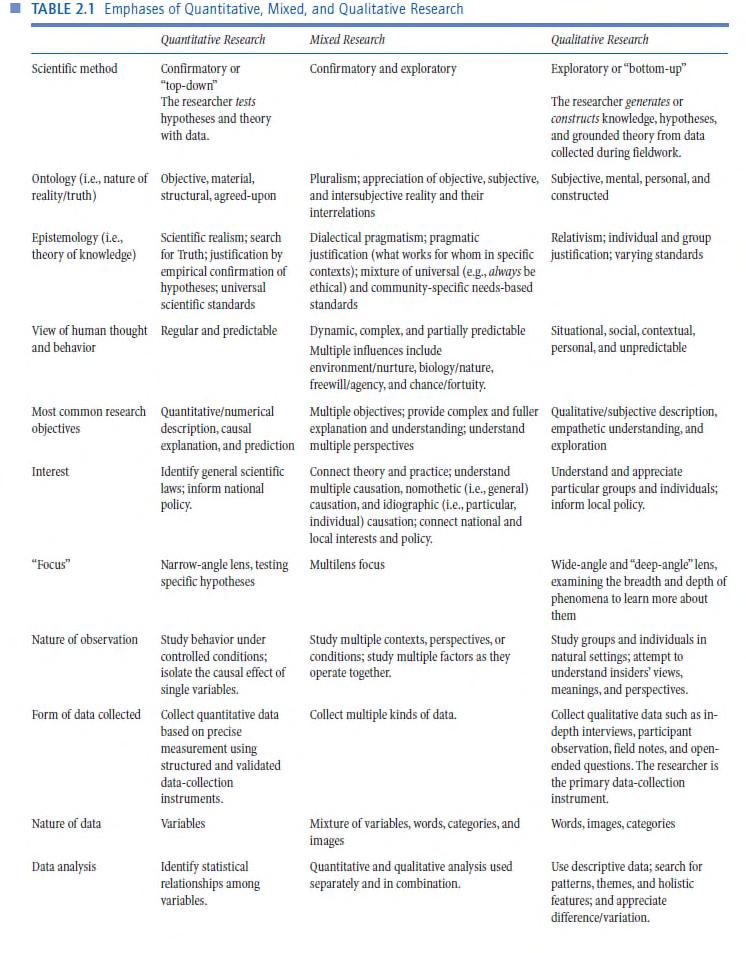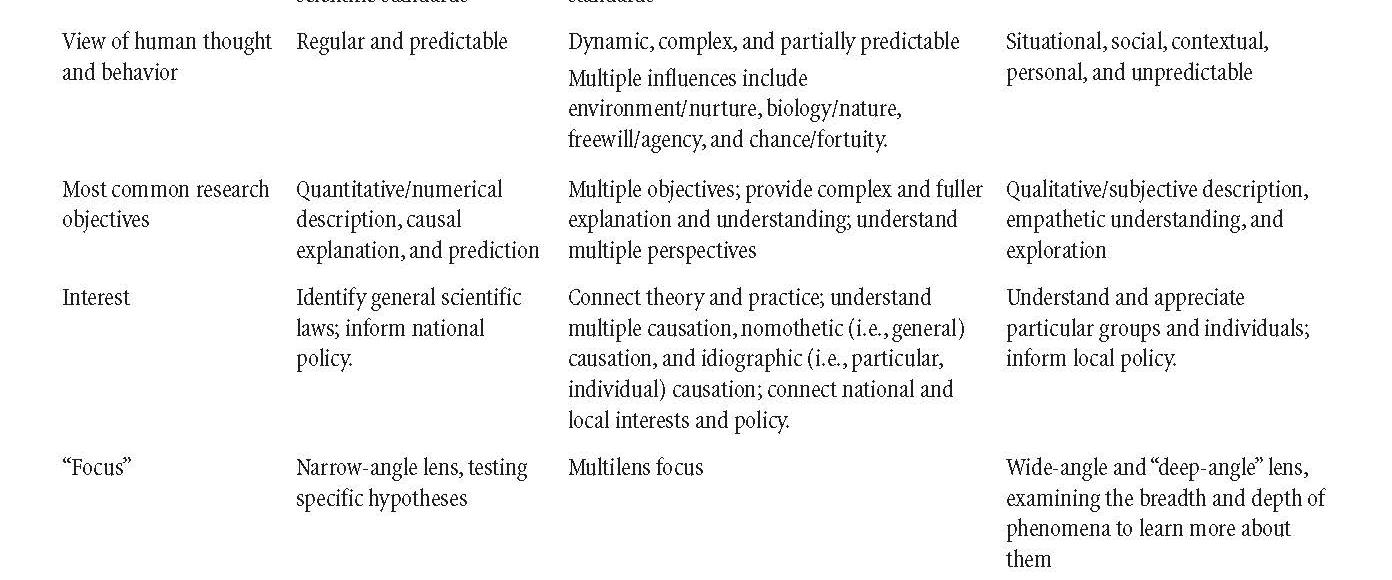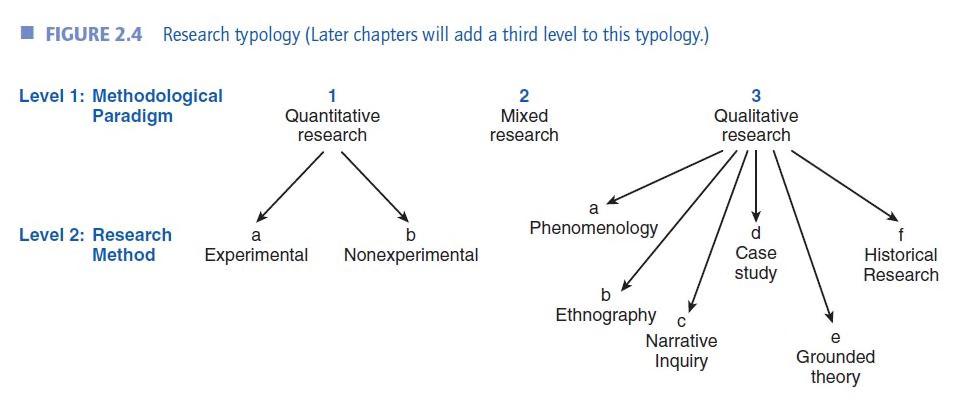

Chapter 2: Quantitative, Qualitative, and Mixed Research
Answers to Review Questions
2.1. What are the key features of quantitative and qualitative research?
Just look at Table 2.1, which shows the key characteristics of these two approaches in their pure or extreme forms as well as the characteristics of mixed research. I will mention a few of these here. Quantitative research uses the deductive or confirmatory or “top down” scientific method; it is used primarily for description, explanation, and prediction. It is based on quantitative data, in particular on the analysis of variables. The results describe statistical relationships and a goal is to generalize the results. In qualitative research, in contrast, the “bottom up” or inductive exploratory method is used; it is used primarily for the purposes of description and exploration and to gain an understanding of how people think and experience their lives. It is based on qualitative data which during analysis are examined for patterns, themes, and holistic features. A narrative report is presented and generalization is usually not a goal because the focus is on the local, the personal, and the subjective.
Here is Table 2.1 on the two next pages for your convenience:




2.2. What are the key features of mixed methods research?
Mixed research is the third and newest research methodology paradigm. As you can see in Table 2.1 it tries to mix the best of qualitative and quantitative research into research studies. Philosophically, mixed research takes an eclectic, pragmatic, and commonsense approach, suggesting that the researcher mixes quantitative and qualitative in a way that works best for the given research question being studied in a particular context. Mixed research often uses both deductive and inductive methods, obtains both quantitative and qualitative data, attempts to corroborate and complement findings, and takes a balanced approach to research. Later in the chapter you will learn about the fundamental principle of mixed research which states that when planning and conducting mixed research, the researcher should mix methods or procedures in a way that the resulting mixture or combination has complementary strengths (broadly viewed) and nonoverlapping weaknesses.
2.3. What is the difference between a categorical variable and a quantitative variable? Think of an example of each.
A categorical variable varies in type or kind and a quantitative variable varies in degree or amount. An example of the former is gender, and an example of the latter is class size.
2.4. Why is experimental research more effective than nonexperimental research when a researcher is interested in studying cause and effect?
Strong experimental research designs (i.e., the best experiments) include both manipulation and random assignment; nonexperimental research has neither of these. “Manipulation” is an action taken by the researcher in the world (e.g., providing a treatment to one group and a control condition to another group); manipulation allows us to see a manipulation first, and then observe the outcome or result of the manipulation. “Random assignment” makes the groups similar on ALL extraneous variables at the beginning of the experiment; hence, the only difference between the groups will be the level of independent variable received, allowing the differences observed after the experiment is completed to be attributed to the manipulated independent variable.
2.5. What are the main problems with the simple cases of causal-comparative and correlational research?
The problem with BOTH of these simple cases is that the researcher has no manipulation and no random assignment, and is only able to determine whether a statistical relationship
is present. Observing a relationship is NOT enough information to attribute causation! To make a causal attribution, you need to meet three conditions: (1) show that there is a relationship; (2) show that you have the correct time ordering of your variables, that is, if A causes B then A must precede B in time; and (3) all alternative explanations must be ruled out. Again, all the simple cases give us is a relationship (i.e., condition 1). (On the other hand, a well-conducted strong experiment satisfies all three conditions.)
2.6 What are two variables that you believe are positively correlated? Study time the night before an exam and test grades (i.e., the greater the study time, the higher the grades).
2.7. What are two variables that you believe are negatively correlated? Amount of time spent partying the night before a test and test grades (i.e., the greater the time spent partying, the lower the grades).
2.8. What are the different types of qualitative research, and what is the defining feature of each of these?
The types are phenomenology, ethnography, narrative inquiry, case study research, and grounded theory research. Here are the definitions, with the key ideas underlined:
(a) Phenomenology: A form of qualitative research in which the researcher attempts to understand how one or more individuals experience a phenomenon.
(b) Ethnography: A form of qualitative research focused on describing the culture of a group of people.
(c) Narrative inquiry: A form of qualitative research that is focused on the study of life experiences as storied phenomenon.
(d) Case study research: A form of qualitative research that is focused on providing a detailed account of one or more cases.
(e) Grounded theory research: A qualitative approach to generating a theory from the data that the researcher collects.
2.9. What is mixed research, and what is an example of this kind of research?
Mixed research (also commonly called mixed methods research) is research in which the researcher uses a combination of quantitative and qualitative approaches in a single research study. Example: study the members of the snake handling churches in the Southern Tennessee/West Georgia using participant observation and using quantitative measurement instruments to profile the participants on variables of interest. Both sorts of data will likely provide useful information.
2.10. What are the three research paradigms in education and what are the major types of research in each of these paradigms? (Hint: See Figure 2.4.)
They are quantitative research, qualitative research, and mixed research. Quantitative research has two major subtypes: experimental and nonexperimental research. Qualitative research has six major subtypes: phenomenology, ethnography, narrative inquiry, case study, grounded theory, and historical research. Mixed methods research uses a combination of quantitative and qualitative research methods.
Here is Figure 2.4 for your convenience.



Chapter 2
Quantitative, Qualitative, and Mixed
Research


Johnson/Christensen, Educational
Three Research Methodology
Paradigms


• Paradigm –perspective based on set of assumptions, concepts, and values that are held and practiced by a community of researchers.

Johnson/Christensen, Educational
Three Research Methodology Paradigms (cont.)

• During most of the 20th century, quantitative was dominant.
• During the 1980s, qualitative became increasingly popular as alternative to quantitative.
• During the 21st century, mixed research has become increasingly popular as alternative to quantitative and qualitative.

– Mixed research is a unique paradigm –it uses bothquantitative and qualitative.

Johnson/Christensen, Educational Research 6th Edition
Characteristics of the Three Research Paradigms

• Quantitative research –research that relies primarily on quantitative data.
o Pure quantitative follows all of the paradigm characteristics of quantitative.
• Qualitative research –research that relies on qualitative data.
o Pure qualitative research follows all of the paradigm characteristics of qualitative.

• Mixed research –mixing of quantitative and qualitative methods or other paradigm characteristics.
o The possibilities for mixing are almost infinite.
See Table 2.1 Emphases of Quantitative, Mixed, and Qualitative Research in textbook
Johnson/Christensen, Educational
Research

Edition
Quantitative Research Methods:
Experimental and Nonexperimental


Basic building blocks of quantitative research are variables.
• Variables (take on different values or categories).
• Constants (single value or category of variable).

Johnson/Christensen, Educational

Table 2.2 Common Types of Variables
Classified by Level of Measurement and by Role of Variable






Measurement Variable Types

• Quantitative variables vary in degree or amount (e.g., annual income).
• Categorical variables vary by type or kind (e.g., gender).

Johnson/Christensen, Educational
Roles Taken by Variables

• Independent variables ("IV") –presumed cause of outcomes.

• Dependent variables ("DV") –presumed effect or outcome.
– To make a cause and effect claim, you must rule out extraneous variables (variables competing with IV in explaining DV).
• You will learn how to “control for” extraneous variables.

Johnson/Christensen, Educational
Major Types of Quantitative Research

Experimental

Nonexperimental Johnson/Christensen,

Experimental Research

• Purpose –determine and demonstrate cause and effect relationships.

• Defining characteristic –active manipulation of an independent variable.

• Strongest experimental designs have random assignment (produces "equivalent" groups).
Johnson/Christensen, Educational Research 6th Edition
Example of Experiment

PretestTreatmentPosttest

Where:
• E stands for experimental group (e.g., new teaching approach).
• C stands for control or comparison group (e.g., the old or standard teaching approach).
• O stands for measurement of DV.
• Bestway to make the two groups similar at beginning is to randomly assign participants to groups.

Johnson/Christensen, Educational
Logic of Experiment

1.Form similar groups at start (random assignment if possible).
2.Pretest participants on DV.
3.Manipulate IV.
4.Posttest participants on DV.

For example: try new teaching method with experimental group and do not change instruction for control group; see which group scores higher.

Johnson/Christensen, Educational
Experimental Research

• Extraneous variable: variable that competes with independent variable in explaining outcome.

• Confounding variable: extraneous variable that was not controlled and leads to a “confounded” result.

• Control by random assignment to experimental and control groups.
Johnson/Christensen, Educational
NonexperimentalResearch

• By definition, nonexperimental has no manipulation of IV.

• Therefore, nonexperimental is not as good as experimental for studying cause and effect.
• Sometimes nonexperimentalis categorized as causal-comparative (IV is categorical and DV is quantitative) or correlational (IV and DV quantitative).

Johnson/Christensen, Educational
NonexperimentalResearch (cont.)

In “simple case” of causal-comparative research, one categorical IV and one quantitative DV.

• Example: Gender (IV) and class performance (DV).
• Look for the relationship by comparing male and female participants’ average performance levels.

Johnson/Christensen, Educational
NonexperimentalResearch (cont.)

In “simple case” of correlational research, one quantitative IV and one quantitative DV.

• Example: Self-esteem (IV) and class performance (DV).
• Look at the relationship between the variables by calculating the correlation coefficient.

Johnson/Christensen, Educational
Correlation Coefficient

• Varies between –1 and +1, and 0 stands for no relationship.
• Two characteristics: strength and direction.
• Strength: the farther from 0, the stronger the relationship.
o +1 and -1 are strongest.
• Direction:
o If positive sign (+.65) positive correlation (two variables move in the same directions). High school GPA and SAT scores.

o If negative sign (e.g., -.71) negative correlation (two variables move in opposite directions). Number of school absences and grades.

Johnson/Christensen, Educational
Remember

1.Obtain MUCH stronger evidence for causality in experimentalresearch than nonexperimental research. (Experimental is better for cause and effect!)

2.In nonexperimental: cannot conclude causation from relationship between one IV and one DV.
3.Three required conditions for causality: relationship, temporal order, and lack of alternative explanation.

Johnson/Christensen, Educational
Remember (cont.)

• Experiments meet the three criteria for causality quite nicely.
• Simple cases of causal comparative and correlational studies do not.
• Simple cases of nonexperimentalresearch can be improved (explained in Chapter 14).

•
But remember: if you want to claim causation then CONDUCT AN EXPERIMENT.

Johnson/Christensen, Educational
Qualitative Research Methods

• Phenomenology –attempts to understand how one or more individuals experience a phenomenon.
o Example: interview 20 special education teachers who describe their experiences in the classroom.

• Ethnography –discovers and describes the cultural characteristics of group.
o Note: culture is shared attitudes, values, norms, practices, language, and material things of a group of people.
o Example: attend an inner city school and document culture and educational practices.

Johnson/Christensen, Educational
Qualitative Research Methods (cont.)

• Narrative Inquiry –using stories to understand people’s lived experiences.
o Example: stories of students who have been successful in school.

• Case study research –provides detailed account of one or more cases.
o Example: study classroom given new curriculum for technology use.

Johnson/Christensen, Educational
Qualitative Research Methods (cont.)

• Grounded theory –inductively generates and develops a theory from data.
o Example: collect data from parents who have pulled children from public schools and develop theory to explain how and why.


Johnson/Christensen, Educational
Mixed Research

• Type of research in which quantitative and qualitative methods, techniques, or other paradigm characteristics are mixed in one overall study (or, occasionally, in a set of related studies).
o Example: study the quantitative and qualitative aspects of a school.


Johnson/Christensen, Educational
Mixed Research (cont.)

• Fundamental principle of mixed research: mix quantitative and qualitative methods, procedures, and paradigm characteristics to design studies with complementary strengths and nonoverlapping weaknesses.

• Metaphor: Construct fish net out of several fish nets that have holes. New net has no holes.
• Corroboration: different approaches provide same result.
• Other purposes compatible with principle: complement via multiple perspectives, expanding results, and discovering what might be missed by using only one research method.

Johnson/Christensen, Educational
Figure 2.4 Research Typology





Johnson/Christensen, Educational
